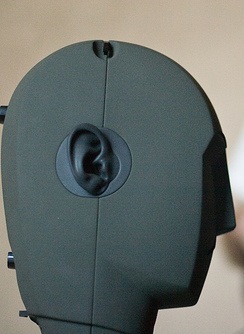 OK, so I’m definitely not the first person to have heard of this. In fact, according to YouTube, I’m roughly the 7,664,000th. Still, as a self-proclaimed science and audio nerd, I can’t help reposting for those who may not have come across it before. It’s called holophonic or binaural sound recording. It’s a method of recording sound to create the illusion of 3D space, to essentially trick your brain. How is this different from surround sound? Because it takes into account the shape of your head, the fact that you have two ears and the fact that the very presence of your head affects how sound waves are received by your ears. A normal microphone picks up sound in a simplistic manner, turning sound waves into an electrical signal but not analyzing the sound in any way (duh, it’s a microphone!). Unlike a microphone, your brain brain interprets the differences in sound intensity and timing between your ears to map the location of the sound, giving you a sense of your 3D environment even if your eyes are closed. Anyways, Luigi does a much better job explaining it… Please note: You must use headphones when listening to these or you will have absolutely no idea what I’m talking about. And it works better if you close your eyes.
One thing that comes to mind in listening to these is: why isn’t holophonic sound used more often? It seems like this technique would be great for films and video games. But, in fact, these are some of the few recordings freely available online. My guess…
1) Holophonic sound requires an entirely different kind of audio set-up (complete with fake plastic head and two microphones) making it much more complicated to record, especially for something long and complex like a film/video game. 2) Holophonic films/games wouldn’t make much sense unless you were seeing from the viewpoint of the characters, which would make for a Blair-Witch-style cinematic experience. Plus you’d have to wear headphones. 3) Mapping sounds as you move around (either in a film or video game) would make everything even more complicated. So, the applications are rather limited, at least for now, though I hope there will be more use of this technique in the future just because it’s so entertaining. Here are a bunch more for your listening pleasure!
1 Comment
|
Archives
April 2015
Categories |
 RSS Feed
RSS Feed